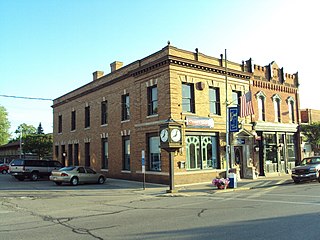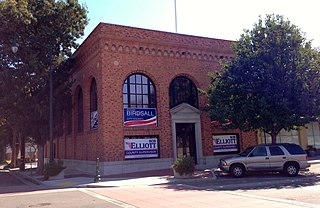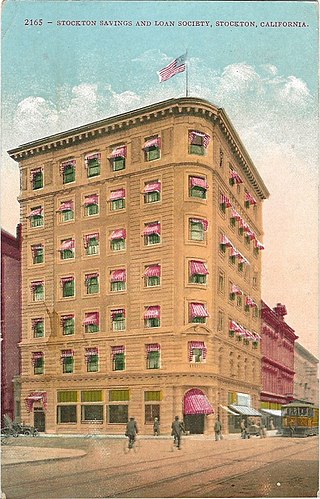Bank of Italy is the Bank of Italy or Banca d'Italia, the central bank of Italy.

Rancho Petaluma Adobe is a historic ranch house in Sonoma County, California. It was built from adobe bricks in 1836 by order of Mariano Guadalupe Vallejo. It was the largest privately owned adobe structure built in California and is the largest example of the Monterey Colonial style of architecture in the United States. A section of the former ranch has been preserved by the Petaluma Adobe State Historic Park and it is both a California Historic Landmark and a National Historic Landmark. The Rancho Petaluma Adobe State Historic Park is located on Adobe Road on the east side of the present-day town of Petaluma, California.

The Bank of California Building, also known as the Durham & Bates Building and currently the Three Kings Building, is a historic former bank building in downtown Portland, Oregon, United States. It has been on the National Register of Historic Places since 1978. The three-story building was designed by A. E. Doyle in an Italianate style and completed in 1925. The ground floor features a two-story-high grand room with 36-foot (11 m) ceilings. The building's original owner and occupant, the Bank of California, moved out around the end of 1969 and sold the building in 1970. It has had a succession of other owners and tenants since then. It was last used as a bank in 1977.

The Bank of Italy Building, also known as the Clay-Montgomery Building, is a building in San Francisco, California. This eight-story building became the headquarters of A. P. Giannini's Bank of Italy in 1908 after the 1906 San Francisco earthquake and fire destroyed the original bank building on Montgomery Avenue in the nearby neighborhood of North Beach. The building was designated a National Historic Landmark in 1978 for its association with Giannini, who revolutionized retail banking in the early 20th century.

The Ríos-Caledonia Adobe is a historic adobe house in San Miguel, California. Built in 1835 by Petronilo Ríos, the adobe is a California Historical Landmark. Today, the Ríos-Caledonia Adobe is open to the public as a house museum and library.

The Park Avenue House is a high rise residential building located at 2305 Park Avenue in the Park Avenue Historic District in Downtown Detroit, Michigan. It was listed on the National Register of Historic Places in 1996. It should not be confused with the nearby Park Avenue Hotel, which was demolished in 2015.

The Edward Schulmerich House is a two-story private residence on East Main Street in downtown Hillsboro, Oregon, United States. Completed in 1915, the American Craftsman Bungalow style structure was constructed for state senator Edward Schulmerich and added to the National Register of Historic Places in 1991. The building retains much of the original materials used in finishing the interior, including the linoleum in the kitchen and built-in cabinets of this Airplane Bungalow.

The Worcester Five Cents Savings Bank is a historic bank building at 316 Main Street in Worcester, Massachusetts. The six story Romanesque Revival building was constructed in 1891 to a design by Stephen Earle. The building is unusual in downtown Worcester for its use of limestone and buff brick, and for its rounded corner bay. The building originally had plate glass and iron store fronts on its ground floor, but this was redone in matching limestone sometime after 1949.

Paso Robles, officially El Paso de Robles, is a city in San Luis Obispo County, California, United States. Located on the Salinas River about 30 mi (48 km) north of San Luis Obispo, the city is known for its hot springs, abundance of wineries, production of olive oil, almond orchards, and playing host to the California Mid-State Fair.

The Pioneer State Bank No. 36 is a bank building located at 4046 Huron Street (M-90) in the village of North Branch in North Branch Township in northern Lapeer County, Michigan. The bank stands as the oldest bank institution in North Branch. It was designated as a Michigan State Historic Site on October 23, 1979 and later added to the National Register of Historic Places on April 22, 1982.

The Hines Mansion is a historic house in Provo, Utah, United States. It is listed on the National Register of Historic Places. It was built in 1895 for R. Spencer Hines and his wife Kitty. At the time the mansion was built, it was recognized as one of the finest homes in Provo. The Hines Mansion was designated to the Provo City Historic Landmarks Registry on March 7, 1996.

The Bank of Italy is a historic bank building located at the intersection of Main and Canal Streets in Merced, California. Opened in 1928, the bank was Merced's branch of the Bank of Italy. Henry A. Minton designed the building in the Classical Revival style. The bank's design includes a flat, clay tile roof with terra cotta mansards and an ornamental cornice and frieze. Five Corinthian columns are situated on the building's Main Street facade, and seven pilasters face Canal Street. The first and second floors of the bank are separated by a decorative band of panels; the band features alternating square panels displaying an Indian head or an eagle separated by rectangular panels with a diamond design. The building's exterior is mostly faced in Travertine marble; the base is faced in granite, and parts of the first floor were covered with stucco in the 1950s.

The Paso Robles Carnegie Library is a Carnegie library located in Paso Robles City Park in Paso Robles, California. The library was built from 1907 to 1908 through a $10,000 grant from the Carnegie Foundation. Architect William H. Weeks, who designed several other buildings in the city, designed the library in the Classical Revival style. The projecting front entrance of the building has an ornamented pediment supported by two columns and two wide brick pilasters. The building has a decorative cornice, and an ornamental frieze is located beneath the pediment and cornice at the entrance. The Works Progress Administration expanded the back of the library in 1939. The library operated until 1995, when it was replaced by a new building and purchased by the city's historical society.

Wheeler Bank is a historic building located on Manitou Avenue in Manitou Springs, Colorado built by Jerome B. Wheeler. It is on the National Register of Historic Places. Over the course of its history, the building has been a financial institution, auditorium and retail business.

The Civic Center Financial District is a historic district composed of five buildings near the intersection of Colorado Boulevard and Marengo Avenue in Pasadena, California. The Security Pacific Building and the Citizens Bank Building are located at the intersection itself and considered the centerpieces of the district, while the MacArthur, Mutual, and Crown Buildings are located on North Marengo. The buildings, which were built between 1905 and 1928, are all architecturally significant buildings used by financial institutions in the early 20th century.

The First National Bank Building is a historic high-rise in Andalusia, Alabama. The tallest building in Andalusia, the six-story building was designed by Montgomery architect Frank Lockwood, who also designed the Covington County Courthouse which sits across the square. The building was listed on the National Register of Historic Places in 1982.

The Bank of Italy in Tracy, California, also known as the Old Bank of America Building, the American Bank of Tracy, and the Kagehiro Building, is a historic bank building completed in 1919. It was added to the National Register of Historic Places in 1985.

The Bank of Tracy is a historic commercial building in Tracy, California, completed in 1920. It was added to the National Register of Historic Places in 1980.

The Michigan Trust Company Building, also known as the Michigan Trust Building or just the Trust Building, is an office building located at 40 Pearl Street NW in Grand Rapids, Michigan. It was listed on the National Register of Historic Places in 1983.

Stockton Savings and Loan Society Bank is a historic commercial building completed in 1908. It is located on 301 East Main Street in Stockton, California. The landmark was added to the National Register of Historic Places on October 19, 1978.





















